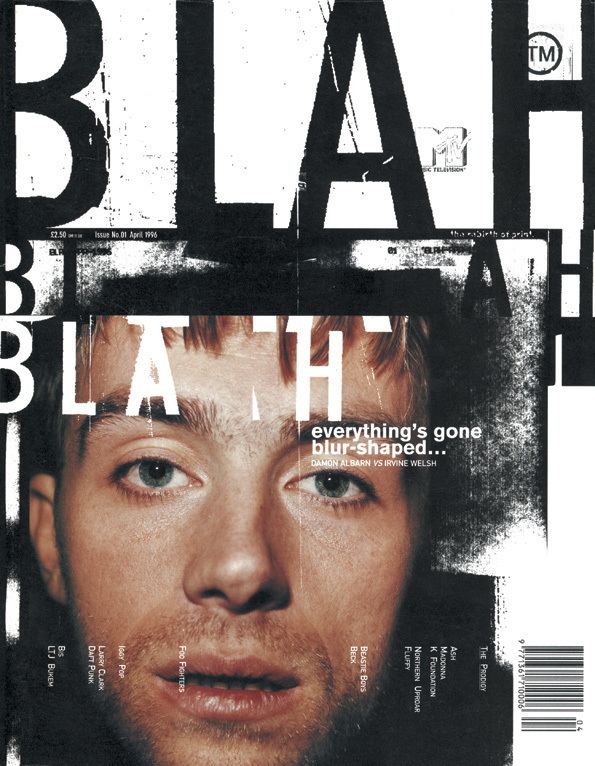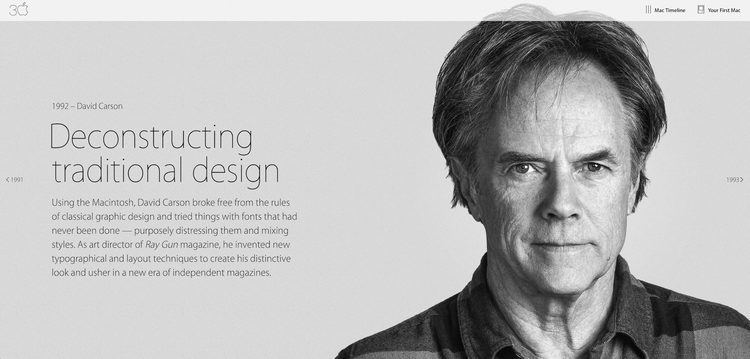Nationality American Name David Carson | ||
 | ||
Artwork Don't mistake legibility for communication Similar People Neville Brody, Stefan Sagmeister, Paula Scher, Milton Glaser, Saul Bass Profiles | ||
David Carson (born September 8, 1955) is an American graphic designer, art director and surfer. He is best known for his innovative magazine design, and use of experimental typography. He was the art director for the magazine Ray Gun, in which he employed much of the typographic and layout style for which he is known. In particular, his widely imitated aesthetic defined the so-called "grunge typography" era.
Contents
- David carson experimental typography in graphic design
- Early life and career
- First art direction
- Ray Gun
- David Carson Design
- Later work
- Analysis and accolades
- Publications
- Awards
- References

David carson experimental typography in graphic design
Early life and career

Carson was born on September 8, 1955 in Corpus Christi, Texas.

He attended Cocoa Beach High School, was class president for 3 years, and still considers Cocoa Beach, Florida to be the place he is "most from".

He attended San Diego State University, graduating with "Honors and Distinction" a Bachelor of Arts in Sociology.

Carson's first contact with graphic design was in 1980 at the University of Arizona during a two-week graphics course, taught by Jackson Boelts.
From 1982 to 1987, Carson worked as a teacher in Torrey Pines High School in San Diego, California. During that time, he was also a professional surfer, and reached a 9th in the world ranking. Carson had his own signature model surfboard with Infinity surfboards, and his own signature model fin with rainbow fin co. He still surfs regularly at his property in Cane Garden Bay.
In 1983, Carson started to experiment with graphic design and found himself immersed in the artistic and bohemian culture of Southern California. He attended the Oregon College of Commercial Art, only for a couple months before accepting an unpaid internship with Action Now magazine, formerly Skateboarder magazine.That year, he went to Switzerland to attend a three-week workshop in graphic design. The teacher of the workshop, Hans-Rudolf Lutz, became his first great influence.
First art direction
Carson became the art director of Transworld Skateboarding magazine in 1984, and remained there until 1988, helping to give the magazine a distinctive look. By the end of his tenure there he had started to develop his signature style, using "dirty" type and non-mainstream photographic techniques.
He was also the art director of a spinoff magazine, Transworld Snowboarding, which began publishing in 1987.
Steve and Debbee Pezman, publishers of Surfer magazine (and later Surfers Journal) tapped Carson to design Beach Culture, a quarterly publication that evolved out of a to-the-trade annual supplement. Though only six quarterly issues were produced, the tabloid-size venue—edited by author Neil Fineman—allowed Carson to make his first significant impact on the world of graphic design and typography—with ideas that were called innovative even by those that were not fond of his work, in which legibility often relied on readers' strict attention. For one feature on a blind surfer, Carson opened with a two-page spread covered in black. After Beach Culture, Carson re designed Surfer magazine and art directed and design it for the next 2 years, before starting Ray Gun Magazine for 3 years. Carson then relocated his studio to New York City, where he still works today.
Ray Gun
Carson was hired by publisher Marvin Scott Jarrett to design Ray Gun, an alternative music and lifestyle magazine that debuted in 1992.
In one issue, he notoriously used Dingbat, a font containing only symbols, as the font for what he considered a rather dull interview with Bryan Ferry. (However, the whole text was published in a legible font at the back of the same issue of Ray Gun, complete with a repeat of the asterisk motif).
Ray Gun made Carson well known and attracted new admirers to his work. In this period, he was featured in publications such as The New York Times (May 1994) and Newsweek (1996).
David Carson Design
In 1995, Carson left Ray Gun to found his own studio, David Carson Design, in New York City. He started to attract major clients from all over the United States. During the next three years (1995–1998), Carson was doing work for Pepsi Cola, Ray Ban (orbs project), Nike, Microsoft, Budweiser, Giorgio Armani, NBC, American Airlines and Levi Strauss Jeans, and later worked for a variety of new clients, including AT&T Corporation, British Airways, Kodak, Lycra, Packard Bell, Sony, Suzuki, Toyota, Warner Bros., CNN, Cuervo Gold, Johnson AIDS Foundation, MTV Global, Prince, Lotus Software, Fox TV, Nissan, Quiksilver, Intel, Mercedes-Benz, MGM Studios and Nine Inch Nails.
He named and designed the first issue of the adventure lifestyle magazine Blue, in 1997. David designed the first issue and the first three covers. Carson's cover design for the first issue was selected as one of the "top 40 magazine covers of all time" by the American Society of Magazine Editors.
In 2000, Carson closed his New York City studio and followed his children to Charleston, South Carolina, where their mother had relocated them. Since then he has lived in San Diego, Seattle, Zurich, and Tortola . Currently he lives and works in NYC.
Later work
In 2004, Carson became the freelance Creative Director of the Gibbes Museum of Art in Charleston. That year, he also designed the special "Exploration" edition of Surfing Magazine and directed a variety of TV commercials, including Lucent Technologies, Budweiser, American Airlines, Xerox, UMPQUA Bank and numerous others.
In 2011 Carson worked as worldwide creative director for Bose Corporation. He also served as Design Director for the 2011 Quiksilver Pro Surfing contest in Biarritz, France, and designed the branding for the 2012 Quiksilver Pro in New York City. He designed a set of three posters for the San Sebastián International Film Festival in Spain and the covers for Huck, Little White Lies, and Monster Children magazines. He has been featured in over 280 interviews worldwide. The international design magazine CASA called Carson, in a cover story in 2014 "The Most Famous Graphic Designer in the World".
Carson was invited to judge the European Design Awards in London (DD+A) in both 2010 and 2011, and was the keynote speaker of the Fuse branding conference in Chicago in 2014 and the international creativity festival in Dubai in 2015.
Since 2010, he has lectured, held workshops and exhibitions across Europe, South America and the United States.
in 2015, Carson was commissioned to design the posters and publicity for the Harvard Graduate School of Design, for the 2015–2016 school year, including a set of over 30 poster designs for events and speaker series.
Analysis and accolades
In a feature story, Newsweek magazine said of Carson that he "changed the public face of graphic design".
His layouts featured distortions or mixes of 'vernacular' typefaces and fractured imagery, rendering them almost illegible. Indeed, his maxim of the 'end of print' questioned the role of type in the emergent age of digital design, following on from California New Wave and coinciding with experiments at the Cranbrook Academy of Art.
When Graphic Design USA Magazine (NYC) listed the “most influential graphic designers of the era” David was listed as one of the all time 5 most influential designers, with Milton Glaser, Paul Rand, Saul Bass and Massimo Vignelli.
Carson claims that his work is "subjective, personal and very self indulgent".
Design writer Steven Heller has said, "He significantly influenced a generation to embrace typography as an expressive medium". Design educator and historian Ellen Lupton said after the release of Carson's book Trek, "David Carson continues to be one of the world's most distinctive typographic voices—much imitated, but never matched" (ID Mag.nyc). AIGA (the American Institute of Graphic Arts) called Carson "our biggest star". The magazine Eye produced a graphic chart showing Carson to be the most 'Googled' graphic designer ever.
Carson continues to lecture throughout the world.
Publications
In November 1995, Carson published his first book, End of Print. It sold over 200,000 copies in five different languages and soon became the best-selling graphic design book worldwide. His second book, 2nd Sight, followed in 1997. In 1998, Carson worked with Professor John Kao of the Harvard Business School on a documentary entitled The Art and Discipline of Creativity. Carson's third book was Fotografiks (1999) which earned Carson the Award of Best Use of Photography in Graphic Design. Carson’s fourth book, Trek, was released in 2000.
Carson is also featured in The History of Graphic Design by Philip Meggs and The Encyclopedia of Surfing by Matt Warshaw.
Awards
David Carson has won over 230 Awards for his work in graphic design, photography, advertising and branding. Some of these awards include:
